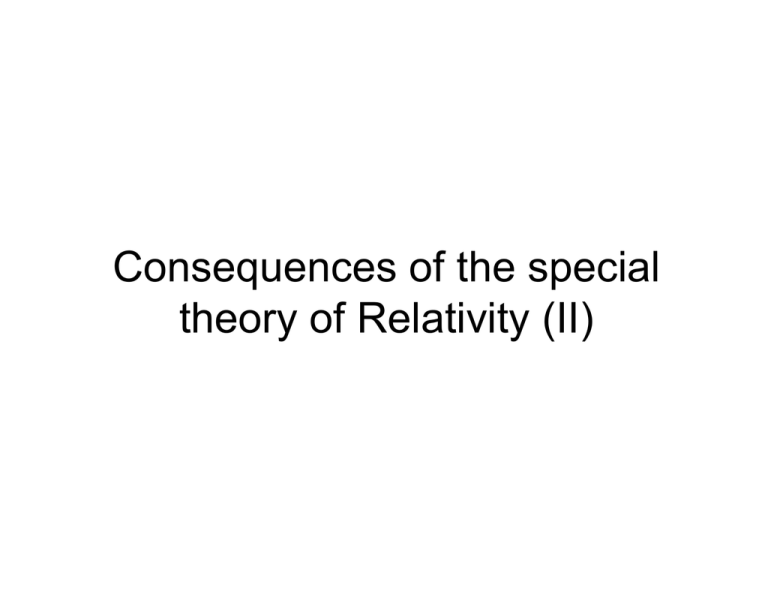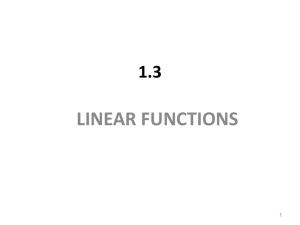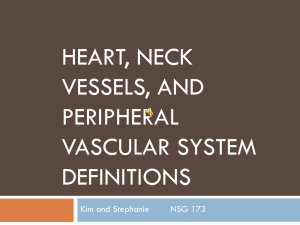Consequences of the special theory of Relativity (II)
advertisement

Consequences of the special theory of Relativity (II) Relativity of Length L0 E: Emitter R: Receiver E R v v E R E R E R L+vΔt1 L-vΔt2 [See Applet] Length Contraction • For the outside observer: – It takes Δt1 for the light to do the first part of the trip and Δt2 for the second part. cΔt1 = L+vΔt1 cΔt2 = L-vΔt2 Δt1 = L/(c-v) Δt2 = L/(c+v) Δt = Δt1 + Δt2 = 2(L/c)(1-v2/c2)-1 Time Dilation effect: Δt = γΔt0 with We deduce: L = L0√(1-v2/c2)= γ-1L0 L0: rest length or proper length ; objects appear contracted in the direction of motion Example What length will observers measure for a spaceship moving relative to them at 0.99c if its occupants determine the length of the ship to be 50m ? L = 50γ-1 = 50 x (1-(0.99)2c2/c2) = 7.1 m A word on time dilation and length contraction • The two descriptions should be equivalent [see Muon decay] • Both observers see the time dilation and length contraction affecting the other observer [see Twin Paradox]. • In both cases, if v<<c L≈L0 and Δt ≈Δt0 (back to classical mechanics) Muon (µ) decay • Muons originates from cosmic-rays Experiment: 1000 muons traveling at 0.98c detected at 2000m, ~540 muons “survived” (did not decay) at see level Radioactive Decay Law: -ln2.t/T N(t)=N0(t)e with T=1.52µs, the half-life of µ It takes 2000/(0.98c)=6.8µs for the µ’s to travel 2000m. According to classical physics, N(6.8µs) ~ 45 µ’s only should be left Time Dilation ! • For the observer on earth, time appears dilated, t = γt0 , e.g. the µ appears to live longer than its rest half-life T: Tearth=7.64 µs • Muons surviving at sea level: -ln2.(6.80/7.64) N(sea level) = N(7.64µs) = 1000 e ~ 540 Length Contraction ! • One should be able to get the same results by solving the problem with length contraction • You’re a muon ! You are to travel at 0.98c a distance of L0=2000m measured by an earth observer, how much distance will you measure according to your meter stick ? L = γ-1L0 L = √(1-(0.98)2) x 2000 = 398m • The µ travels the distance in: t = 398/0.98c = 1.35µs • After this time, N(left) = N(1.35µs) = 1000e-ln2.(1.35/1.52) ~ 540 SAME RESULT ! Note: Don’t forget to use T=1.52 µs, the half-life of the µ at rest, since we are in the referential of the µ ! Space - Time • Nothing can travel faster than the speed of light. Therefore, there are regions of space and time that cannot be reached (CAUSALITY). Simultaneity / Non-simultaneity Lightning at x3 (Left) x1,x2,x3 stationary (Right) x1,x2,x3 moving The “Stanley/Mavis” problem Stanley: The two events “lightning strike hits (A)” and “lightning strike hits (B)” are simultaneous. Mavis: The two events “lightning strike hits (A’)” and “lightning strike hits (B’)” are NOT simultaneous. ct ct v Stanley (in his own ref frame) c A Mavis (in Stanley’s ref frame) c Stanley B c x A c Mavis B x ct’ Mavis (in her own ref frame) c A’ c Mavis B’ x’ Spacetime interval • Length contraction / Time dilation – Length and time are not the same in two inertial frames moving with respect to one another at a sizeable fraction of c • Is there an invariant quantity that measures the same in both reference frame? Yes. Δs2 = (Δx2+Δy2+Δz2) - (cΔt)2 ; Δs2 (in K) = Δs’2 (in K’) • Using only 1-D of space (x): two events described by (x1,t1) and (x2,t2) can be expressed by: Δs2 = (x1-x2)2 - c2(t1-t2)2 (SPACETIME INTERVAL) [interval]2 = [separation in space]2 - [separation in time]2 Spacetime interval • Lightlike interval: – Δs2 = 0 (Δx2 = c2Δt2): the two events can only be connected by a light signal • Spacelike interval: – Δs2 > 0 (Δx2 > c2Δt2): the two events cannot be causally connected. • Timelike interval: – Δs2 < 0 (Δx2 < c2Δt2): the two events can be causally connected. The twin paradox • Two twins: one travels, one stays at home. The traveler ages slower than its twin, who stayed on earth. But, relatively speaking, who is moving ? • The paradox: both are moving with respect to the other, therefore they should age the same way ! • Answer: The one that is really “moving” (e.g. feeling the effect of time dilation) is the one accelerating and decelerating. [See textbook] Exercise Determine the decrease in length of a space shuttle (L0=50m) traveling 17,000 miles/h relative to the earth observers. v = 17000 mi/h = (17000 x 1.61 x 103) / 3600 = 7.6 x 103 m/s Length contraction: L = γ-1 L0 = L0 √( 1 - (7.6 x 103 )2/(3.0 x 108)2 ) = L0 √ ( 1 - 6.4 x 10-10 ) Contraction = L0 – L = 1.6 x 10-8 m !!!!




